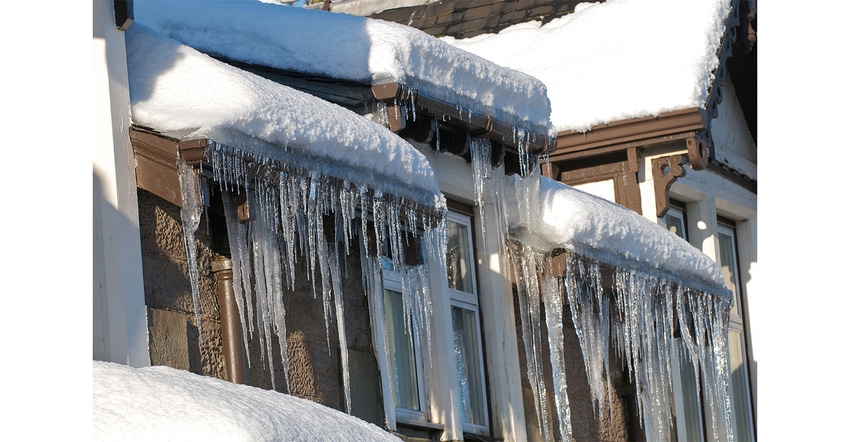The Roofs of Winter
The winter weather that impacts many parts of the country can make roofing seem like a seasonal trade, but as many of you can attest, installations, repairs and replacements happen at all times of the year, including when the weather is not at its most cooperative.

The winter weather that impacts many parts of the country can make roofing seem like a seasonal trade, but as many of you can attest, installations, repairs and replacements happen at all times of the year, including when the weather is not at its most cooperative.
The key to a successful result when roofing in cooler weather comes down to being prepared and knowing how to handle and install roofing materials when the show, or, more accurately, the shingles, must go on.
Roofing in winter can bring with it the additional burdens of working in bulkier clothing, navigating less stable footing due to weather conditions and coping with the reality that we don’t tend to move as quickly or nimbly when we’re cold. This is why it’s even more important to take safety precautions when temperatures drop, and long sleeves and jackets start making their way onto job sites.
Fall protection is a must when working at heights, including on a roof. Safety harnesses and guardrails add a level of safety, and given the additional risk of slips and fall in colder weather, appropriate fall protection and/or barriers should be top of mind for anyone managing a roofing crew.
According to the Canadian Centre for Occupational Health & Safety, protective clothing is needed for work at or below 39°F (4°C). The level and duration of the job activity and the weather conditions should be considered when selecting appropriate clothing. It is advisable to dress in layers as the air between each layer helps insulate against the cold while providing flexibility to shed layers to adjust for changing temperatures and weather conditions throughout the day.
If snow or ice is present or could be present, take extra time and use extra caution. The Asphalt Roofing Manufacturers Association (ARMA) suggests waiting until a roof is free of ice and frost for safer roof application; so, if a stretch of sunny days is in the forecast, it may be best to wait. If waiting is not in the cards, make safety a top priority.
The National Institute for Occupational Safety and Health lists falling as the No. 1 cause of construction injuries and fatalities. As such, a roofer’s footwear should have good traction to help reduce the likelihood of a slip-and-fall injury. This is especially important if there is a risk of snow or ice being present.
Cold doesn’t only impact a roofing crew. Many materials, including asphalt shingles, starter materials, underlayment and ice-and-water protectors can also be impacted by the cold. Many items that are typically flexible in the summer can become rigid or even brittle in temperatures below 50°F (10°C). Make yourself familiar with cold-weather installation instructions for all of the products you use.
Materials stored outside are at the greatest risk of being impacted by the cold. Where possible, it is advisable to store shingles and other roofing materials in a heated or warm location, like a garage or shed. Even a few hours in a warmer environment can make materials easier to handle and install. When applying asphalt shingles in cooler temperatures, avoid bending, dropping or throwing them as they may be brittle from the cold and more easily damaged.
Some experts advise leaving the air-powered guns in the truck and nailing by hand in cold weather, since high-powered impacts from a nail gun could damage the shingles, causing cracks or holes if nails blow through the materials.
Proper installation of most asphalt shingles also relies on a factory-applied self-sealing line of sealant designed to help adhere the shingle to the previous course. This helps resist uplift due to wind, but for the self-sealing strip to do its job, the shingles need to be exposed to several days of direct sunlight and warm temperatures, and, as such, adhesion may be impacted by colder weather.
Most asphalt shingle manufacturers provide instructions in their installation guides to address situations where there is a risk of shingles not self-sealing to one another. This typically includes a requirement to manually seal the shingles with shingle adhesive cement when installing shingles in cooler weather.
Industry organization ARMA also recommends the use of an asphalt adhesive cement in cold weather, advising the use of an adhesive that has been approved by the shingle manufacturer. This is also likely a requirement of the shingle’s warranty. If in doubt, consult the installation instructions and the warranty documents for the line and brand of shingles that you are installing.
Just because it’s started to get cold outside doesn’t mean you have to put the tools away for the winter. Just be sure to tread carefully on the job site, handle your materials with care and always, always, always read and follow the manufacturer’s instructions.
About the Author(s)
You May Also Like






